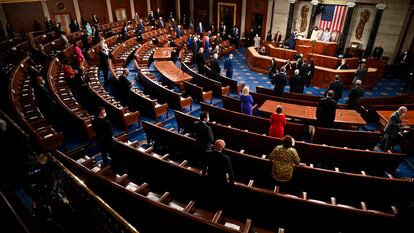The United States Congress speaks more Spanish than ever
The Hispanic Council analyzed the communications of 541 lawmakers in the country and found that 102 communicate officially with their constituents in the language


The Spanish-speaking community in the United States is growing at the rate of one million people a year. There are now 57 million Americans, out of a total of 331 million, who either understand Spanish or use it as their primary language of communication. The increase is reflected in the government: more and more US politicians are composing internal and external communications in the language. The report by the Hispanic Council, an entity that promotes cultural relations between Spain and the United States, includes the findings from a survey of public communication–including on social networks and in press releases and official documents–of 541 politicians in the US Congress and the Senate since September 2020.
The study, which will be presented next Monday at the Spanish Congress of Deputies, shows that 74 of 441 newly elected US congressmembers issue digital communications in English and Spanish, an 18% increase from 2018. And of the country’s 100 senators, 28 already address their constituents in the language, twice as many as just four years ago. Daniel Ureña, president of The Hispanic Council, explains that “in political terms, the Hispanic community is already the minority group with the greatest electoral weight. Knowing that this vote is increasingly decisive in United States politics, the use of Spanish among representatives of Congress has been increasing.”
Politicians who communicate with the electorate in Spanish do not all come from Hispanic backgrounds. In fact, there are only six Hispanic representatives in the Senate, but 28 senators use Spanish. The report highlights, among them, Debbie Lesko (Arizona), Cory Booker (New Jersey), Kirsten Gillibrand (New York), John Cornyn (Texas ) and Bill Cassidy (Louisiana), all perhaps motivated by the significant percentages of Spanish speakers in their respective districts. Among parties, Democrats are more inclined to use the language than Republicans: 28.8% of 222 Democratic congressmembers already do so.
The US Hispanic community includes 61 million people, although only 57 million speak Spanish. Today it represents 18.7% of the US population, while in 2010 it accounted for 14.2%. It will be the fastest-growing population group in the coming decades, given that the number of people under 18 years of age is greater than that of adults; 47.7% of inhabitants of New Mexico, 39.4% of California residents and 39.3% of Texans are of Hispanic origin, these groups having grown by 6%, 11.2% and 20.9%, respectively in the last decade. In 2000, only 10 states registered a Hispanic population of more than 10%, increasing to 23 states in 2020 and 27 in 2022. By 2060, it is estimated that this segment of citizens will reach 27.5% of the total United States population. One in four Americans will have Spanish as their mother tongue.
Jackie Kennedy’s campaigning
The use of Spanish entered US electoral politics in 1960, during the election campaigns of Democrat John F. Kennedy and Republican Richard Nixon. The Democrats developed an advertising campaign for Jackie Kennedy, the candidate’s wife, in which she called for votes in Spanish. In 1988, George H. W. Bush’s strategists prepared four ads in Spanish to attract the Hispanic vote. The strategy tipped the balance in their favor in states where the Hispanic ballot was decisive. In the last elections, advertising in Spanish increased Hispanic electoral participation by 15 percentage points, reaching a record figure of 65%.
The language’s use in parliamentary politics has spread so much that 14 congressional committees (15% of the total) use communications in Spanish. The Ethics Committee has the highest percentage of documents in Spanish (30%), followed by Energy and Commerce (24.1%) and Natural Resources (23.8%).
A total of 492 million people have Spanish as their mother tongue in the world, and 591 million speak it. Together, its speakers represent 7.5% of the world population, making it the second most used language in the world after Mandarin Chinese with 950 million speakers. In professional settings, it is the third most common language after Chinese and English. The United States is now the country in the world with the second-largest population of Spanish speakers, surpassed only by Mexico.
In addition, according to the report, 24 million American students chose to study Spanish as a foreign language in 2021, two million more than the previous year and three more than in 2019. “In the United States, Spanish is unrivaled as the most studied language in all levels of education,” says Ureña.

Two hundred years ago, Joseph Marion Hernández (1788-1857) became the first Hispanic member of the United States Congress, as a representative from the state of Florida. Since then, the Hispanic community has rapidly grown in politics, though it has frequently been the subject of political controversies, from the crisis of the Spanish-American war of 1898, to debates among leaders about whether to assimilate or reject the nation’s social customs.
Henry B. González (1916-2000) was one of the first Hispanic politicians to advocate for the group’s representation in day-to-day politics in the United States. The House of Representatives and the Senate were, in his opinion, the two places where Hispanics could best defend their interests. He was a representative of Texas from 1961 to 1999, and he is known for an iconic quote: “If we cry in an empty room, we can only hope to hear our voices.” When he delivered the message in 1971, he did so in English. In 2022, he surely would also have said it in Spanish.
Tu suscripción se está usando en otro dispositivo
¿Quieres añadir otro usuario a tu suscripción?
Si continúas leyendo en este dispositivo, no se podrá leer en el otro.
FlechaTu suscripción se está usando en otro dispositivo y solo puedes acceder a EL PAÍS desde un dispositivo a la vez.
Si quieres compartir tu cuenta, cambia tu suscripción a la modalidad Premium, así podrás añadir otro usuario. Cada uno accederá con su propia cuenta de email, lo que os permitirá personalizar vuestra experiencia en EL PAÍS.
¿Tienes una suscripción de empresa? Accede aquí para contratar más cuentas.
En el caso de no saber quién está usando tu cuenta, te recomendamos cambiar tu contraseña aquí.
Si decides continuar compartiendo tu cuenta, este mensaje se mostrará en tu dispositivo y en el de la otra persona que está usando tu cuenta de forma indefinida, afectando a tu experiencia de lectura. Puedes consultar aquí los términos y condiciones de la suscripción digital.
More information
Archived In
Últimas noticias
The operation in Venezuela to capture Maduro threatens to widen the cracks in the MAGA movement
Trump clarifies who is ultimately in charge in Venezuela: ‘Me’
Maduro pleads not guilty before the federal court in New York: ‘I am still the president of Venezuela’
A new test can detect Alzheimer’s from a finger prick
Most viewed
- Gilles Lipovetsky: ‘If you want to live better and fall in love, take Prozac, don’t look to philosophy’
- Alain Aspect, Nobel laureate in physics: ‘Einstein was so smart that he would have had to recognize quantum entanglement’
- Alvin Hellerstein, a 92-year-old judge appointed by Bill Clinton, to preside over Maduro’s trial in New York
- Why oil has been at the center of Venezuela-US conflicts for decades
- Cuba confirms death of 32 of its citizens in the US attack against Venezuela










































